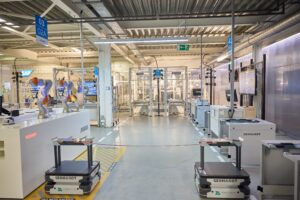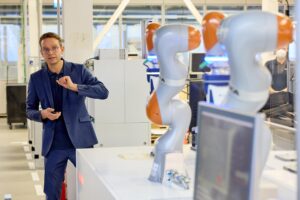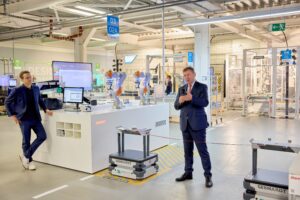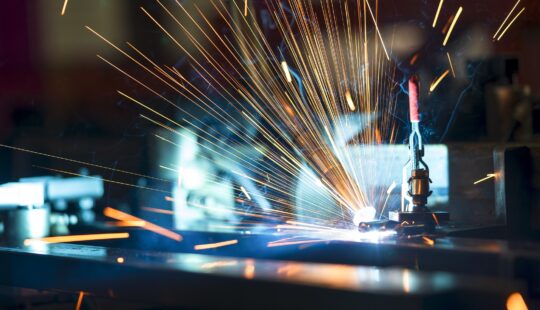“The benefits of SAP solutions are not always obvious to customers,” said Andre Bechtold, head of Value Experience at SAP, at an event marking the reopening of the SAP Experience Center on the Walldorf campus and the launch of the Industry 4.0 Pop-Up Factory just a short walk away. Together, they give customers and partners the chance to experience the company’s solutions, technologies, and innovations live in action.
CEO and Member of the Executive Board of SAP SE Christian Klein told media representatives, customers, and SAP employees how much this particular endeavor means to him. As one of the world’s largest business software vendors with customers generating 87% of total global commerce, Klein emphasized that SAP software is used to run highly complex business processes. The two exhibits illustrate how SAP works closely with customers and partners to find solutions to the challenges they face.
Now, in its very own exhibition space covering more than 500 square meters, SAP can demonstrate exactly what its digital supply chain and Industry 4.0 solutions can do. “It is important that customers can come and see all this for themselves,” Klein stated.
Inside the Industry 4.0 Pop-Up Factory
The Industry 4.0 Pop-Up Factory is built like an actual factory and features, among other things, robots for component production that support the worker during manufacturing. The exhibit has an entire production line for mixing and filling liquids, as used in the process industry, and even driverless transport systems. The focus is on Industry 4.0 for customers in the process manufacturing sector – chemicals, pharmaceuticals, and consumer goods, for example. The setup also addresses the needs of discrete manufacturing like machinery, vehicles, and electronics. SAP’s smart factory showcases have evolved – and grown – over the years and can now all be seen in action together under one roof as a pop-up installation in rented premises.
The idea is to allow customers to experience the digital supply chain for themselves through showcases. By seeing the software in operation, they gain a better understanding of its capabilities. All stages of the product life cycle are demonstrated in a real-life setting, from product design, planning, and manufacturing through to logistics and maintenance. At the pop-up factory, SAP wants to show how it has a broad portfolio of solutions for end-to-end processes and is a leader in digital supply chain and integrated supply chain.
The pop-up factory presents different lines of business, incorporates real equipment and machinery, and runs the same SAP products as those that are shipped to customers. Not all the showcases are new, but, as Ralf Lehmann from Solution Management for Digital Manufacturing and Industry 4.0 says: “The new factory allows us to bring everything together under one roof and to demonstrate realistic end-to-end scenarios.”
Industry 4.0 Is Already Here – And It Goes Beyond Technology
The purpose behind Industry 4.0 is to use smart technologies to generate sustainable economic and social benefits. The term itself is often used simply to denote the Internet of Things (IoT) in industry, though this is not its full meaning. In fact, Industry 4.0 encompasses far more than technology. It also describes a new way of organizing and managing the value stream throughout the product life cycle. The challenges here, though, are becoming increasingly complex. Customers today have highly specific requirements and very different priorities and expectations, ranging from personalized experiences to sustainable and ethical business practices.
Seeing Industry 4.0 In Action
The Industry 4.0 Pop-Up Factory is unique: “It demonstrates the benefits of SAP solutions in a realistic setting and allows customers and partners to see how they work in the real world and in a setup that is very similar to their own shop floor,” says Matthias Deindl, head of Industry 4.0 Center EMEA & India.
The idea of a demonstration factory was born in the conference halls of Germany’s Hannover Messe trade show. Each year, SAP presented showcases and product lines to demonstrate the capabilities of its solutions and technology. Customers would come to SAP’s stand and ask how they could recreate the scenarios at their companies. They wanted to know how it all worked and where they could see the solutions in action in the real world. In response, the existing showcases have been continuously developed over the years and now find their own home in the new Industry 4.0 Pop-Up Factory.
SAP has worked closely with its hardware partners for many years. Setting up the demonstration factory provided a great opportunity for a joint project with companies in the automation technology field. Among them are Arkite, asentics, Beckhoff, Endress+Hauser, Evoguard, Gebhardt, Google, intranav, item, Kuka, Krones, Kinemic, Mettler Toledo, Navvis, Neoception, OPC UA, Proglove, Rocketfarm, Sartorius, Schunk, SICK, TRUMPF, Universal Robot, and VMT.
Though the pandemic put a temporary end to in-person events, it did not end the plans for a demonstration factory. The team’s brief was: “How can we take our showcases to the people if they cannot come to us?” recalls Lehmann. In the course of this, a TV studio was built specifically to stream digital customer demos.
The Industry 4.0 Pop-Up Factory is designed to be a source of information and inspiration for customers and partners. It offers deep-dive sessions with experts, either in person at the factory or online. SAP has invested in the latest video technology and equipped the entire venue with cameras – not just to give live-stream audiences the best possible experience but also with sustainability in mind.
Positive Feedback: The New Industry 4.0 Pop-Up Factory Delivers
Even before the factory’s doors officially opened, its showcases had been used in more than 400 live sessions with customers and prospects, both in person onsite and remotely via Web meeting. The feedback from customers has been very positive. The remote sessions have been equally well-received. “They have many advantages: you can hear everything, you can see everything, and anywhere from 80 to 100 people can all attend at the same time,” Deindl says. “By offering virtual sessions, we give our customers a way of reducing their carbon footprint.”
Many of the inquiries the factory team receives are from managers overseeing manufacturing processes at our customers. They want their leaders to experience the SAP solutions featured in the Industry 4.0 Pop-Up Factory sessions and see the benefits for themselves.
Besides being able to see the software in action, experts who come to the factory also appreciate the chance to get into conversation with other visitors there. It has created communities in which people regularly share their thoughts and ideas. This not only gives customers confidence but provides the Industry 4.0 Pop-Up Factory’s organizers with valuable feedback. Especially in the critical phase leading up to the buying decision, visiting the factory and talking to others there can give a customer a fuller understanding of the solutions so that they can be sure the decision they are making is the right one.
Do you have questions about the Industry 4.0 Pop-up Factory? Contact us.
Photos by Ingo Cordes



